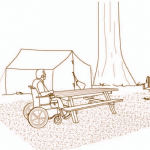Definition [F106.5]
A trail is defined as a pedestrian route developed primarily for outdoor recreational purposes. Pedestrian routes that are developed primarily to connect accessible elements, spaces, and buildings within a site are not a trail.
New Trails [F247.1]
When a trail is designed for use by hikers or pedestrians and directly connects to a trailhead or another trail that substantially meets the technical requirements for trails, the trail must comply with the technical requirements.
Existing Trails [F247.2]
When the original design, function, or purpose of an existing trail is changed, regardless of the reason, and the altered portion of the trail directly connects to a trailhead or another trail that substantially meets the technical requirements for trails, the altered portion of the existing trail must comply with the technical requirements for trails.
The term “reconstruction” is not used in the ABA Standards, though the term is used frequently by the trails community. For the purposes of the ABA Standards, actions are categorized as either new construction or an alteration. Routine or periodic maintenance activities are not considered an alteration that would trigger the application of the ABA standards. The difference between an alteration and maintenance is as follows:
- An alteration is work done to change the original design, purpose, intent, or function of an existing trail.
- Maintenance is the routine or periodic repair of existing trails or trail segments to restore them to their originally designed and built condition. Maintenance does not change the original design, purpose, intent, or function for which a trail is designed. Maintenance may include:
- Removing debris and vegetation, such as fallen trees or broken branches on the trail; clearing the trail of encroaching brush or grasses; and removing rock slides
- Maintaining trail tread, such as filling ruts, reshaping a trail bed, repairing a trail surface or washout, installing riprap to retain cut and fill slopes, and constructing retaining walls or cribbing to support trail tread
- Performing erosion control and drainage work, such as replacing or installing drainage dips or culverts
- Repairing or replacing deteriorated, damaged, or vandalized trail or trailhead structures or parts of structures, including sections of bridges, boardwalks, information kiosks, fencing and railings; painting; and removing graffiti
Technical Requirements [1017]
The technical requirements for trails include specific provisions for the surface, clear tread width, passing spaces, tread obstacles, openings, running slope, cross slope, resting intervals, protruding objects, and trailhead signs.
Using the Trail Exceptions [1017.1, Exceptions 1 and 2]
When a condition for exceptions does not permit full compliance with a specific provision in the technical requirements on a portion of a trail, that portion of the trail must comply with the specific provision to the extent practicable.
When extreme or numerous conditions for exceptions make it impracticable to construct a trail that complies with the technical requirements, the entire trail can be exempted from complying with the technical requirements. An entire trail can be exempted from the technical requirements only after applying the conditions for exceptions to portions of the trail. When determining whether to exempt an entire trail from the technical requirements, consider the portions of the trail or beach access route that can and cannot comply with the specific provisions in the technical requirements and the extent of compliance where full compliance cannot be achieved.





